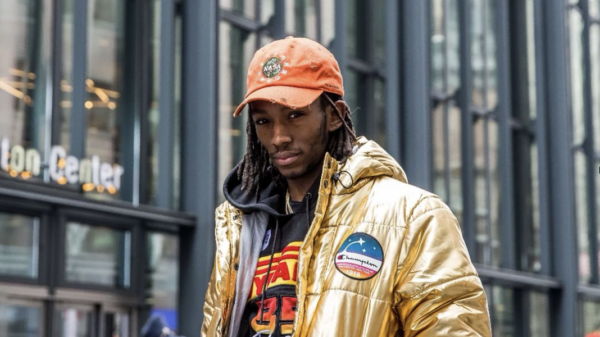Country music’s most famous stage and radio show is marking its 100th anniversary this year with special performances, honors, and a recent three-hour NBC TV special. But fans of country music, and broadcast history too, would be remiss to not seek out a copy of 100 Years of Grand Ole Opry: A Celebration of the Artists, the Fans, and the Home of Country Music. A gorgeously crafted new book by members of the Opry and Nashville author Craig Shelburne, it looks at the institution’s colorful legacy, with photos from all eras, both backstage and under the spotlights.
In this excerpted chapter, titled “You’re Lookin’ at Country,” 100 Years of Grand Ole Opry traces the arrival of cowboy clothing on the Opry stage and explains why dazzling rhinestones and Nudie suits became musts for nearly any Opry performer.
“On December 1, the Grand Ole Opry, WSM’s four-hour Saturday night barn dance, will celebrate its ninth anniversary as one of the most popular programs of its kind ever put on the air. For the first time since the program was started, the performers are dressing their parts. Overalls, hickory shirts and battered hats predominate among the old time fiddlers and banjo pickers while Uncle Dave Macon, long since the star performer, continues to wear his ten-gallon hat, gates-ajar collar and flashes his gold teeth at the spotlight, which plays on him in WSM’s brand new auditorium studio.”
The November 18, 1934, Tennessean documented the Opry’s evolution from a barn dance of the airwaves and imagination—where a few lucky fans could crowd into a radio studio each week—to a stage show where musicians’ costumes reflected the hillbilly image the show cultivated from the beginning. In WSM’s Studio C, five hundred fans per two-hour segment could witness the performances. Even if the hillbilly look was out of character for musicians such as Dr. Humphrey Bate, a harmonica player with a medical degree from Vanderbilt, it was powerful in distinguishing the Opry and underscoring the show’s down-home identity. From then on, each show would be a feast for the eyes as well as the ears.
Editor’s picks
As the Opry attracted more full-time professionals, some musicians felt that the hillbilly image was denigrating, so they took a cue from the cowboy movies dominating the cinematic landscape of the day. Zeke Clements, Texas Ruby Owens, and Pee Wee King donned cowboy hats and colorful Western wear and adopted band names such as the Bronco Busters and Golden West Cowboys. The cowboy style became more fanciful through the 1940s in the hands of Jewish immigrant tailors such as Rodeo Ben in Philadelphia, Pennsylvania, and Nathan Turk and Nudie Cohn in Hollywood, California.
Though small in stature, Little Jimmy Dickens made a sizable impression in 1949 when he took the Opry stage wearing one of Cohn’s creations, which would become known as “Nudie suits”—the first Opry member to do so. In the 1950s, the style was embraced by many top young country stars. As Nudie’s designs became more elaborate and eye-catching, the Opry sparkled with flashing rhinestones and colorful embroidered designs that reflected performers’ individuality. From Hank Snow’s “I’m Moving On” suit with embroidered train motifs to Porter Wagoner’s heavily rhinestoned stage suits decorated with Conestoga wagons and wagon wheels, audiences knew, without a doubt, they were seeing a star.
Stage wear for Opry women proved more conservative in the 1950s. Minnie Pearl’s frilly dress and a $1.98 price tag hanging from her hat became her signature look. Similarly, Kitty Wells and Wilma Lee Cooper dressed modestly, cradling acoustic guitars against their square-dance-style dresses. By the 1960s, women were making more fashionable style choices. Patsy Cline helped usher in elegant cocktail dresses, many made by her mother. Sonny James, Jim Reeves, and other smooth-singing men in the Nashville Sound era opted for trim, modern suits.
Related Content
The 1970s saw a new era of self-expression for women. Loretta Lynn donned floor-length gowns; Dolly Parton’s embellished bell-bottom jumpsuits created an unforgettable silhouette; and Dottie West raised the glam factor with stage wear by Bob Mackie, designer of choice for Cher and Carol Burnett. Success allowed these stars to leave behind the old-fashioned notions of how a woman in country music should look and dress.
The Outlaw and Urban Cowboy eras introduced a much more casual country style, with jeans, cowboy boots, and Western shirts worn by entertainers and their audiences alike. As the nineties rolled around, the look got crisper. Jeans showed an ironed-in crease. Cowboy hats, which were back in style for Clint Black, Terri Clark, and Alan Jackson, were pristine and clean. In the 2000s, the Del McCoury Band, Ricky Skaggs, and Rhonda Vincent carried on the dress-to-impress bluegrass tradition, always looking sharp for their audience.
These days, the Opry stage might showcase fashion inspiration from throughout the show’s history. Banjo player and comedian Mike Snider has been known to sport overalls, Riders in the Sky adhere to the Western look, and Marty Stuart and His Fabulous Superlatives wouldn’t dare come to the Opry without gorgeous custom-tailored Western suits. For his induction, Mark Wills borrowed an embellished jacket that George Jones wore for his final promotional photo. Terri Clark, Jamie Dailey of Dailey & Vincent, and Jamey Johnson are among the Opry artists who turned to esteemed Nashville designer Manuel Cuevas (a protégé of Nudie Cohn simply known as Manuel) for their induction wardrobe.
Trending Stories
Meanwhile, the glamour of a bygone era continues to inspire fashion-forward entertainers such as Sara Evans, Carly Pearce, and Carrie Underwood. Said Underwood, “I always try to dress a certain way for the Opry because of the rich tradition established by women at the Opry. You look at the pictures on the walls, they’re just stunning. And they really respected the Opry and wanted to dress a certain way. I try my best to keep that going.”
Excerpted from the new book 100 Years of Grand Ole Opry: A Celebration of the Artists, the Fans, and the Home of Country Music by Craig Shelburne and the Members of the Grand Ole Opry. Text copyright © 2025 OEG HoldCo, LLC dba Opry Entertainment Group. Photography credits can be found below. Published by Abrams.

























